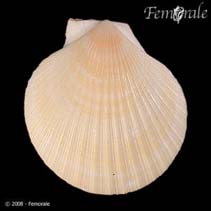Zygochlamys delicatula (Hutton, 1873)
Delicate scallop
Classification / Names Tên thường gặp | Các synonym ( Các tên trùng) | CoL | ITIS | WoRMS
Bivalvia | Pectinida | Pectinidae
Environment: milieu / climate zone / Mức độ sâu / distribution range Sinh thái học
; Mức độ sâu 70 - 400 m (Tài liệu tham khảo 87933). Temperate, preferred 12°C (Tài liệu tham khảo 107945); 33°S - 55°S, 158°E - 179°W
Distribution Các nước | Các khu vực của FAO | Các hệ sinh thái | Những lần xuất hiện | Những chỉ dẫn
Southwest Pacific: Kaikoura, New Zealand to Macquarie Island.
Length at first maturity / Bộ gần gũi / Weight / Age
Chín muồi sinh dục: Lm ?, range 4 - ? cmTuổi cực đại được báo cáo: 10 các năm (Tài liệu tham khảo 126823)
Life cycle and mating behavior Chín muồi sinh dục | Sự tái sinh sản | Đẻ trứng | Eggs | Sự sinh sản | Larvae
Main reference
Các tài liệu tham khảo | Người điều phối | Người cộng tác
SAUP Database. 2006. (Tài liệu tham khảo 356)
IUCN Red List Status
(Tài liệu tham khảo 130435: Version 2024-2)
CITES status (Tài liệu tham khảo 108899)
CMS (Tài liệu tham khảo 116361)
Threat to humans
Human uses
Các nghề cá: Tính thương mại
FAO - Các nghề cá: landings | FishSource | Biển chung quanh ta
Các công cụ
Thêm thông tin
Max. ages / sizes
Length-weight rel.
Length-length rel.
Length-frequencies
Mass conversion
Sự phong phú
Các nguồn internet
BHL | BOLD Systems | CISTI | DiscoverLife | FAO(Các nghề cá: ; publication : search) | Fishipedia | GenBank (genome, nucleotide) | GloBI | Gomexsi | Google Books | Google Scholar | Google | PubMed | Cây Đời sống | Wikipedia (Go, tìm) | Tạp chí Zoological Record



